Japan
Wood Products Prices
Dollar Exchange Rates of 10th
Nov
2023
Japan Yen 151.00
Reports From Japan
Fragility of the
country’s recovery
Japan's economy shrank by an annualised 2.1% in the
July-September period from the previous quarter marking
the first contraction in three quarters and this highlights
the fragility of the country’s recovery and supports the
case for continued Bank of Japan (BoJ) easing as well as
the new economic support package.
The contraction was partly driven by higher import costs
which rebounded from a sharp drop in the spring with net
exports deducting 0.1 percentage points from the overall
GDP figure. The recent data suggest that Japan’s
economic recovery is more fragile than previously thought
and in need of continued government and central bank
support.
BoJ governor Kazuo Ueda has maintained that the bank
will not change its policy until there are clearer signs that
wage increases, price stability and growth are achieved.
See:
https://www.japantimes.co.jp/business/2023/11/15/economy/japan-gdp-shrinks/
In related news, the International Monetary Fund has
forecast that Germany will overtake Japan this year as the
world’s third-largest economy. In its World Economic
Outlook the IMF forecast that Japan’s nominal GDP will
decrease 0.2% from the previous year to US$4.23 trillion
(630 trillion yen) while Germany’s will increase 8.4% to
US$4.43 trillion.
See:
https://www.imf.org/en/Publications/WEO/Issues/2023/10/10/world-economic-outlook-october-2023
Households cut down spending
Household spending in September fell 2.8% from a year
earlier, dropping for the seventh consecutive month as
people cut back spending on food and other items because
of price increases and the decline in real wages.
Purchases of food, which account for around a third of
household spending, decreased almost 4% falling for the
12th straight month. Spending on housing also declined as
repairs and maintenance were put on hold. Other statistics
from the government showed that real, inflation-adjusted
wages in September dropped over 2% from the previous
year for the 18th consecutive month.
See:
https://mainichi.jp/english/articles/20231107/p2g/00m/0bu/006000c
Massive support package to cushion rising costs
The government has agreed a range of measures to help
household finances that have been dealt a blow from
inflation and the rising cost of imports. This package, at
more than 17 trillion yen (US$112 billion), will further
worsen the country's finances.
Analysts are agreed that this initiative will not boost
consumption but could help household finances. The
package includes temporary cuts to income and residential
taxes, cash payments to low-income households and
subsidies for petrol and utility charges. The government
expects the petrol and utility subsidies to reduce consumer
inflation by about 1%.
See:
https://www.reuters.com/markets/asia/japans-kishida-announces-113-bln-package-combat-inflation-pain-2023-11-02/
Slow recovery of earnings drives many companies
under
The number of corporate bankruptcies in Japan jumped
almost 40% to an eight-year high in the April-September
fiscal first half from a year earlier. This came as many
companies found it impossible to repay government relief
loans taken during the pandemic.
During the pandemic bankruptcies were low thanks to the
interest-free, unsecured loans extended by the government.
Business failures are rising as companies experience slow
earnings recovery and higher costs.
See:
https://japannews.yomiuri.co.jp/business/economy/20231011-142431/
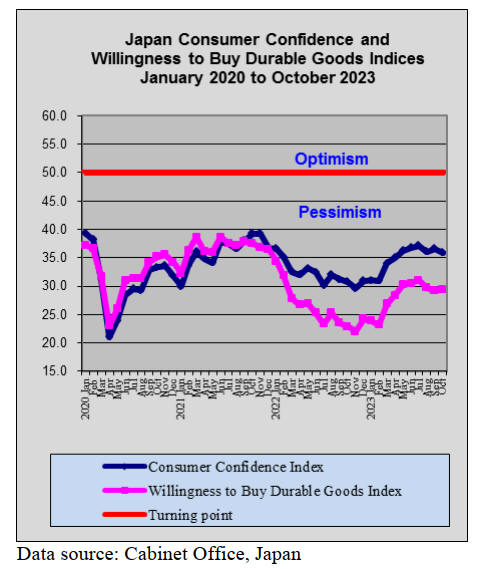
Renouncing inheritance of family apartments
Government figures show Japan is grappling with an aging
population and properties abandoned by the families of the
deceased. This is not only the case in rural areas. In many
resort areas across Japan where, during the economic
bubble time many people invested in luxury apartments,
these are now valued at a fraction of the original price and
require maintenance and for which apartment block
management fees are due. In the face of this many are
giving up on inheriting apartments which leaves the
apartment management short of money to maintain
services to the block.
In the past ten years, there have been more than
10,000
instances of this reported. Urban areas with large
populations, such as Tokyo and Osaka, saw the highest
number of instances but in per capita terms, Niigata
Prefecture's Yuzawa Town topped the list followed by
Atami in Shizuoka Prefecture and other regional tourist
destinations.
See:
https://www3.nhk.or.jp/nhkworld/en/news/backstories/2828/
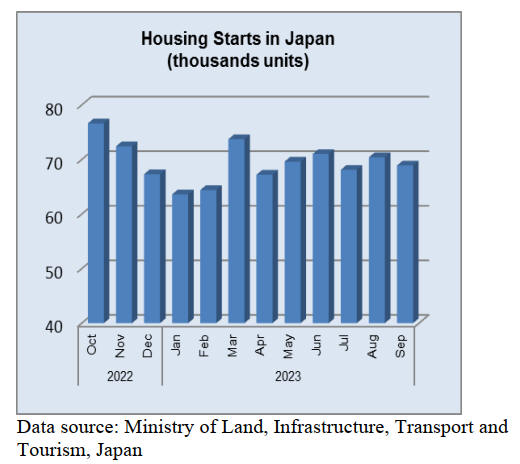
Government tries verbal support for yen
The yen suffered its biggest daily fall against the dollar
since April in early November after the Bank of Japan
made only modest changes to its policy of holding down
government bond yields.
The US dollar/yen exchange rate surged to a 12-month
high of almost 152 in early November prompting
government spokespersons to offer verbal support. Sadly,
the yen's fundamentals are weak and the currency is
comparable to some of the world's worst performing
currencies according to Deutsche Bank.
See:
https://www.ft.com/content/68689510-c413-45ea-91c4-f28cc5f47c4b
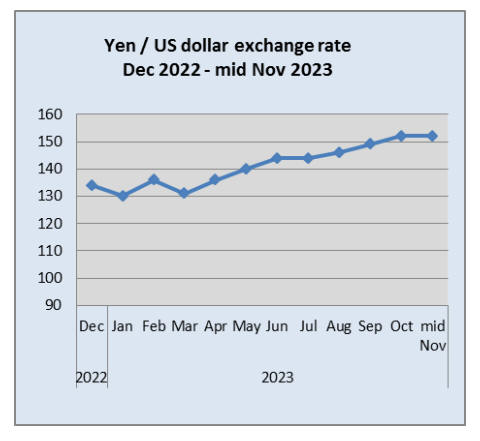
Import update
Assembled wooden flooring imports
The value of Japan’s September imports of assembled
flooring, (HS441871-79) dropped by over 10% year on
year but compared to the value of August imports there
was a 25% increase bringing monthly import values back
the high seen in July.Of the various categories of
assembled flooring imports in September HS441875 was
the largest, accounting for 68% of the total value of
assembled flooring imports followed by HS441879.
The main shippers of HS441875 in August were China
51%, the EU 27% followed by Vietnam, Malaysia,
Thailand and Indonesia. In August there were no recorded
arrivals from Indonesia but shipments resumed in
September.

Plywood imports
For the second straight month there was a rise in the
volume of plywood arrivals in Japan. Since the beginning
of this year the volume of imports had been on a steady
downward trend so the up-tick in August and September is
welcome news for shippers.
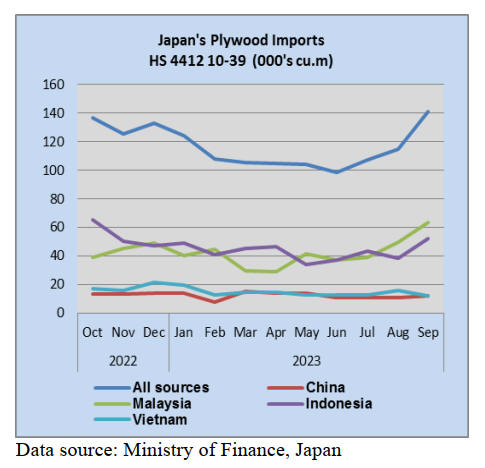
Despite the two good months, year on year the
volume of
plywood imports was down 8% in September but
compared to a month earlier there was a 23% increase
with most of this extra being shipped by Indonesia and
Malaysia with a slight rise in imports from China. The
only loser in September was Vietnam where the volume of
September shipments was down compared to a month
earlier.
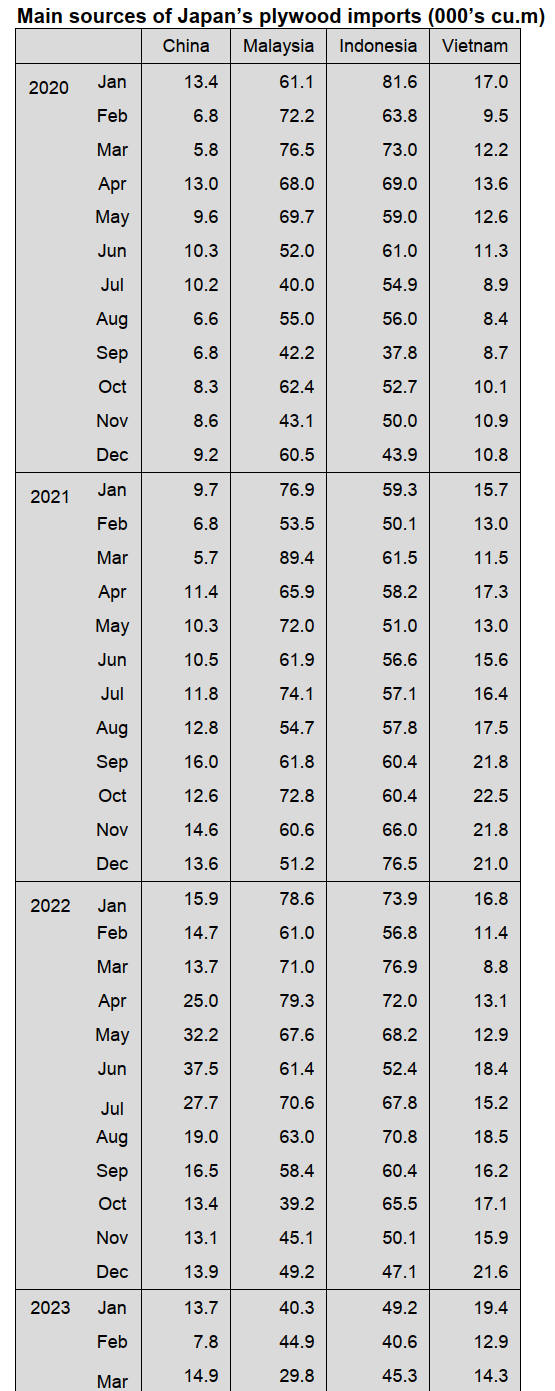 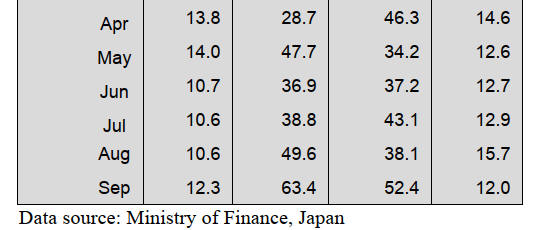
Trade news from the Japan Lumber Reports (JLR)
The Japan Lumber Reports (JLR), a subscription trade
journal published every two weeks in English, is
generously allowing the ITTO Tropical Timber Market
Report to reproduce news on the Japanese market
precisely as it appears in the JLR.
For the JLR report please see:
https://jfpj.jp/japan_lumber_reports/
Demand and supply of domestic softwood plywood
According to the Ministry of Agriculture, Forestry and
Fisheries, shipment of structural plywood in September,
2023 is 201,000 cbms, 6.6 % more than September, 2022.
This is for the first time in thirteen months to be over
200,000 cbms. Shipment is 5 % increased from previous
month. Production of structural plywood is 201,000 cbms,
10.3 % down from September 2022. This is for the first
time in twelve months to be over 200,000 cbms.
Production of over 24 mm plywood is 92,000 cbms, 9.8 %
less than the same month last year but this is 14 % more
than the previous month. Inventory of structural plywood
is 133,000 cbms, 4.1 % more than the same month last
year. This is 0.4 % up from last month.
Inquiries to domestic softwood plywood are bullish even
though demand for houses is low. Shipment at some
distributors in Western Japan has been increasing since
September. However, the demand for houses is unclear in
the future so the distributors purchase domestic softwood
plywood to fill current needs.
The price of domestic softwood structural plywood is on a
slow decline. 12 mm, 3 x 6 is 1,600 yen, delivered per
sheet. Some companies sell the domestic softwood
structural plywood by 1,550 yen, delivered per sheet, for
sales promotion. Shipment of thick softwood structural
plywood is rising. 24 mm 3 x 6 is 3,200 yen, delivered per
sheet, and this is unchanged price from the previous
month. 28 mm 3 x 6 is 3,750 yen, delivered per sheet and
this is also unchanged price from the previous month.
Movement of imported plywood is dull. Arrival volume of
imported plywood has been declining but the inventory of
imported plywood in Japan is not in short supply. Japanese
importers hesitate to buy plywood due to the weak yen and
low demand.
The price of South Sea plywood in South Asia levels off
from last month but some South Asian shippers raised the
price by US$10, C&F per cbm.
The South Asian shippers raised the price because the
inventory of plywood in Japan has been decreasing. 12
mm 3 x 6 painted plywood for concrete form is $670 –
680, C&F per cbm. Structural plywood is US$560 – 570,
C&F per cbm. Form plywood is around $580, C&F per
cbm.
2.4 mm 3 x 6 plywood is around US$950, C&F per cbm.
3.7 mm 3 x 6 plywood is around $880, C&F per cbm. 5.2
mm 3 x 6 plywood is around US$850, C&F per cbm.
These prices have been unchanged since summer.
The price of plywood will be raised in Japan due to the
weak yen. 12 mm 3 x 6 painted plywood for concrete form
is 1,990 – 2,000 yen, delivered per sheet and this is around
50 yen up from September. Structural plywood is 1,800
yen, delivered per cbm. 2.5 plywood is 780 yen, delivered
per sheet. 4 mm plywood is 1,000 yen, delivered per sheet.
5.5 mm plywood is 1,200 yen, delivered per sheet.
Price of standing timber
Japan Real Estate Institute announced the survey of the
price of standing timber at the end of March, 2023. The
price of cedar, cypress and pine timber declined from the
previous survey. The national average of cedar is 4,361
yen, per cbm and this is 12.7 % less than March, 2022.
Cypress is 8,865 yen, per cbm and this is 18.2 % less and
pine is 2,672 yen, per cbm and this is 2.1 % less than the
same month last year. The sizes of cedar, cypress and pine
trees are 20 – 22 cm x 3.65 – 4 m.
This survey began in 1959. The highest price of cedar was
22,707 yen, per cbm in 1980 and of cypress was 42,947
yen, per cbm in 1980.
Orders for house builders
New orders for some house builders in September, 2023
are 10 % less than September, 2022. The housing market
has been sluggish in this year except the beginning of this
year. Some sales staffs say that they could not attract
customers to the display home villages in May, when there
was a long holiday, because many customers went to
leisure facilities. Some results in September, 2023 are
better than the same month last year because the results in
September, 2022 were terrible.
In this year, the customers are cautious to purchase houses
and the house builders have raised the selling price.
Therefore, the number of orders does not rise. However,
some customers start to purchase built for sale houses
because the price of condo is skyrocketing. Orders for
rental houses and for non-housing buildings are still strong .
New system for carbon dioxide emission
Taisei Corporation in Tokyo Prefecture developed a new
system, which calculates an amount of Co2 emissions at
processes of manufacturing building materials, procuring
building materials and building structures. The new
system is the first in the construction industry and is called
‘T – CARBON Navios’. The new system calculates an
amount of Co2 emission automatically on each kind of
building materials by integrated data.
The company has already developed a system for
calculating an amount of Co2 emission at a process of
building structures in 2010 and has been offering the
system to clients. By adding the new system to the existing
system, it will calculate an amount of Co2 emission in a
few minutes accurately.
It took several months to calculate an amount of Co2
emission at processes of manufacturing building materials
before but the new system calculates an amount of Co2
emissions of procuring building materials by just typing a
kind of building materials and a number of building
materials.
Conclusion for promoting use of wood products
Nippon Life Insurance Company in Osaka Prefecture
concludes an agreement with the Ministry of Agriculture,
Forestry and Fisheries in promoting the use of timber. This
is the Japan’s first agreement of a financial company and
the country.
100 wooden buildings will be built by 2030 and 4,800
cbms of timber will be used. Timber must be from
companies which registered Clean Wood Act.
Confusion for importers and exporters
The Japan Lumber Reports in its November 10, 2023 issue
No. 840 reports the following reaction to new regulations
from the Ministry of Agriculture, Forestry and Fisheries
(MAFF): ‘We have to put the exporter’s name on all
imported plywood as of next year’, Japanese importers and
distributors said. Also, they have to put the exporter’s
name on OSB and laminated lumber so Japanese importers
and exporters in overseas are confused. The exporters
overseas say that it is not realistic to put names on every
plywood and laminated lumber.
They have not concluded what to do for this new rule. The
new rule will be effective in February, 2024. There are
many questions about the new rule. What if there were no
exporter’s name on the products after February 2024, what
would happen? Who would pay for this trouble? Some
Japanese importers say that conditions for the new rule
must be written down on the contracts.
There are thirteen kinds of wood products, such as
laminated lumber, structural panels, floorings, plywood,
wooden pellets and so on, under the JAS standards. The
name of the product, of manufacturers, sizes and a kind of
glue must be printed on JAS certificated wood products.
However, there are just names of plants or companies
printed on the products so far.
Then,MAFF guided the Japanese importers and exporters
in foreign countries to follow the rules. Since a Chinese
manufacturer was discovered wrongdoing on plywood last
year, the rules about that become stricter than before.
The MAFF announced Japanese companies and
companies, which are authorized by JAS in overseas, to be
ready for the new rule by the end of January, 2024.
Plants have a certain amount of forecast production and
the products are bundled so it is difficult to put the
exporter’s names on each product. The plants get orders
for products from not only Japana but also other countries.
These situations make Japanese companies to feel anxious
about supply of product from overseas. It might take more
time to deliver the JAS certificated products.
Especially, the Japanese companies are concerned that
laminated structural lumber would be less because
consumers started to purchase laminated structural lumber
instead of Douglas fir lumber. Since there was a fire at
Chugoku Lumber Co., Ltd.’s plant and the company
limited to accept orders for Douglas fir lumber.
The balance of demand and supply for structural lumber
would be influenced by the new rule.
Japanese importers are not sure about the products without
exporter’s name would be treated as non-JAS products or
not. Also, they are wondering about the stocks of products
and there would be punishment or not if there were no
names on the products.
|